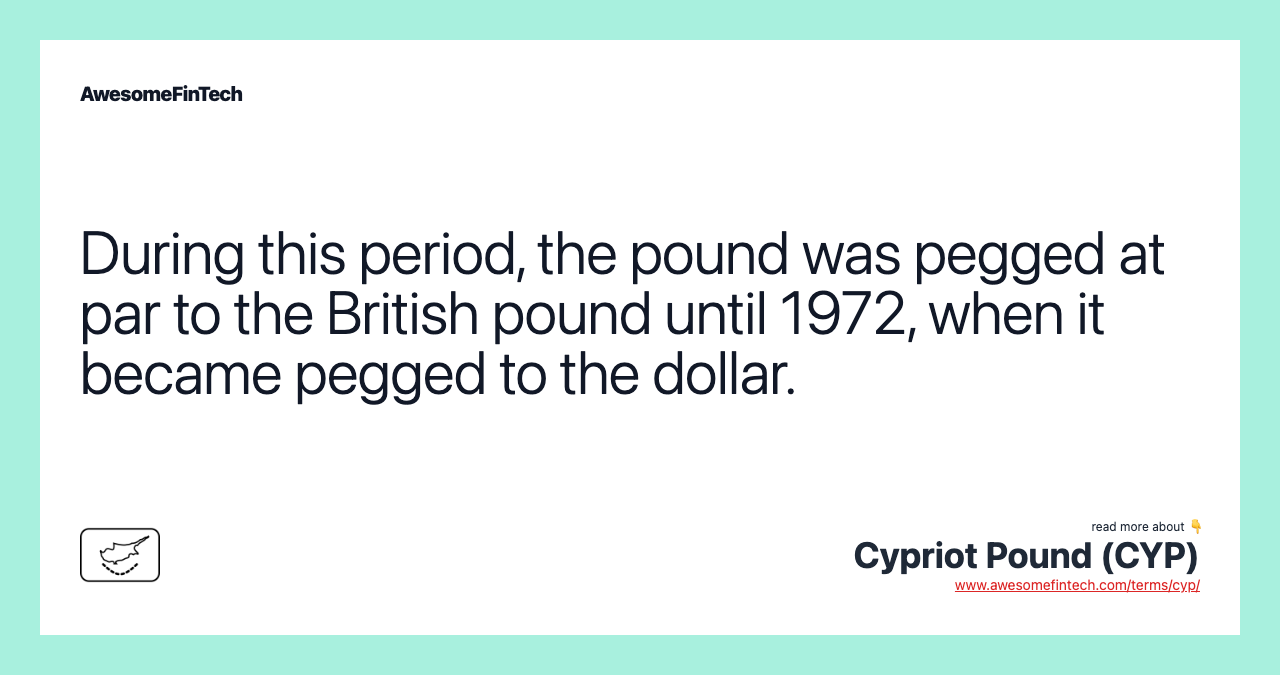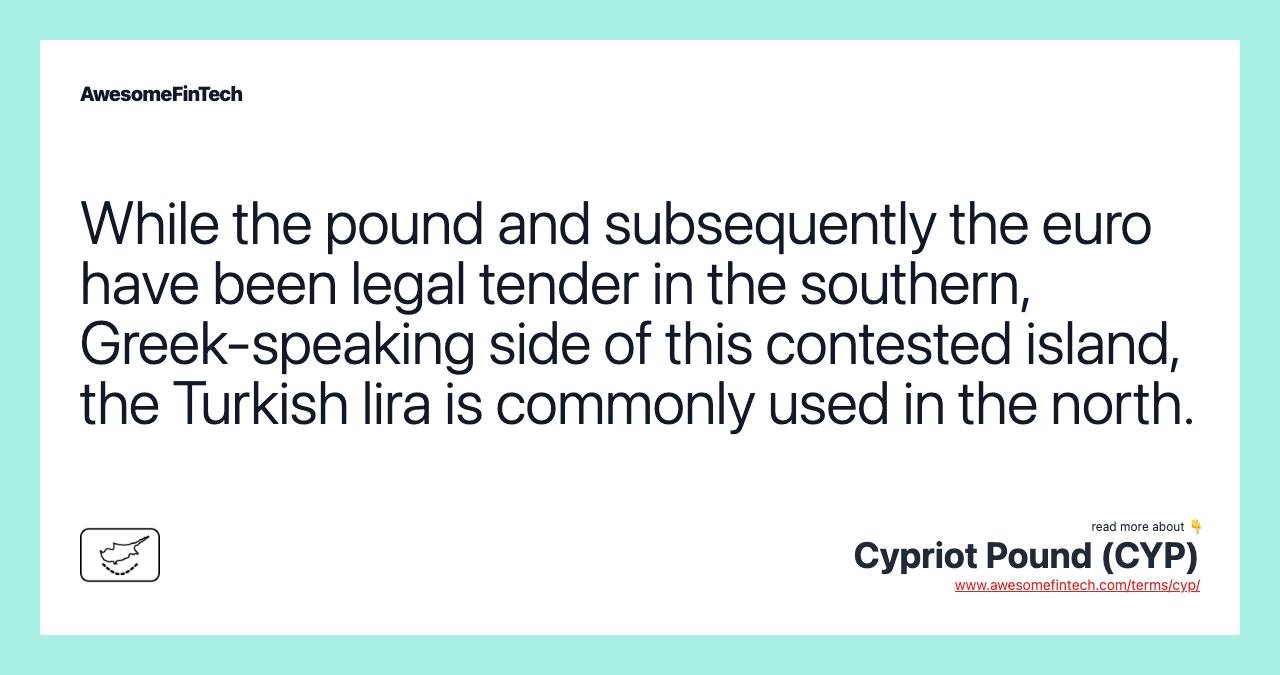Cypriot Pound (CYP)
CYP was the currency abbreviation for the Cypriot pound, which was the national currency of the Republic of Cyprus, prior to its adoption of the common euro currency. CYP was the currency abbreviation for the Cypriot pound, which was the national currency of the Republic of Cyprus, prior to its adoption of the common euro currency. Starting in 1973, the Cyprus dropped its dollar peg in favor of a peg to a currency basket based upon the country's imports, then switched to a currency basket based on the country's trading activities in 1984. Despite the north's technical existence as part of the island of Cyprus, it has maintained the Turkish lira (TRY) as its official currency, though businesses serving tourists often accept payments in euros (EUR), British pounds (GBP) or U.S. dollars (USD). The Cypriot pound was the official currency for Cyprus prior to its membership in the European Union (EU) and adoption of the euro (EUR) as legal tender in 2008.

What Was the Cypriot Pound (CYP)?
CYP was the currency abbreviation for the Cypriot pound, which was the national currency of the Republic of Cyprus, prior to its adoption of the common euro currency.



Understanding the Cypriot Pound
The Cypriot pound was the official currency for Cyprus prior to its membership in the European Union (EU) and adoption of the euro (EUR) as legal tender in 2008. The Central Bank of Cyprus issued and administered the currency following its establishment in 1963. The British first used the pound in Cyprus in 1879, even though the country at the time still belonged to the Ottoman Empire. The Cypriot pound remained pegged to the British pound (GBP) until 1972, at which point the central bank changed the peg to the U.S. dollar.
Starting in 1973, the Cyprus dropped its dollar peg in favor of a peg to a currency basket based upon the country's imports, then switched to a currency basket based on the country's trading activities in 1984.
The decision to move to the euro eventually triggered establishment of a permanent exchange rate of 0.585274 Cypriot pounds per euro. The euro became legal tender effective Jan. 1, 2008. The agreement with the European Central Bank allowed exchange of older pound coins for two years following the changeover and CYP banknotes for the 10 years following.
Cyprus had annual GDP growth of 3.23% in 2019 with an inflation rate of 0.56%.
A Divided Cyprus
Britain annexed Cyprus as a colony following the breakup of the Ottoman Empire in 1925. The nation's inhabitants, however, generally have viewed themselves as either ethnically Greek or Turkish, leading to periods of civil unrest. Greek Cypriots have periodically called for the country to unite with Greece, while Turkish Cypriots have traditionally demanded that the country either unite with Turkey or that the northern part of the country secede. The republic received independence from England in 1960 and almost immediately plunged into periodic violence between Greek and Turkish elements. A coup backed by the U.S. and Greece attempted to assassinate the Cypriot president in 1974 and the resultant fight led to the country's division as Turkish forces entered the northern part of the island.
Turkish Cypriots attempted to formalize the division in 1983, when they declared themselves the Turkish Republic of Northern Cyprus. Other than Turkey, however, no other nation has recognized the republic. Northern and southern factions have tried on multiple occasions to forge a peace plan between the two sides, without result. The north remains occupied and the United Nations oversees and patrols a demilitarized buffer zone between the two territories.
Despite the north's technical existence as part of the island of Cyprus, it has maintained the Turkish lira (TRY) as its official currency, though businesses serving tourists often accept payments in euros (EUR), British pounds (GBP) or U.S. dollars (USD).
Related terms:
Currency Peg
A currency peg is a policy in which a national government sets a specific fixed exchange rate for its currency. Learn the pros and cons of currency pegs. read more
Currency Basket
A currency basket is comprised of a mix of several currencies with different weightings. read more
Euro
The European Economic and Monetary Union is comprised of 27 member nations, 19 of whom have adopted the euro (EUR) as their official currency. read more
European Union (EU)
The European Union (EU) is a group of countries that acts as one economic unit in the world economy. Its official currency is the euro. read more
Exchange Rate
An exchange rate is the value of a nation’s currency in terms of the currency of another nation or economic zone. read more
Foreign Exchange (Forex)
The foreign exchange (Forex) is the conversion of one currency into another currency. read more
GBP
GBP is the abbreviation for the British pound sterling, the official currency of the United Kingdom and its territories. read more
MUR (Mauritius Rupee)
The Mauritius Rupee (MUR) is the national currency of Mauritius is issued by the central bank, the Bank of Mauritius. read more
Polish Zloty (PLN)
The Polish zloty (PLN) is the national currency of Poland, issued by Narodowy Bank Polski. read more
Sudanese Pound (SDG)
The Sudanese pound (SDG) is the national currency of the Republic of Sudan. read more